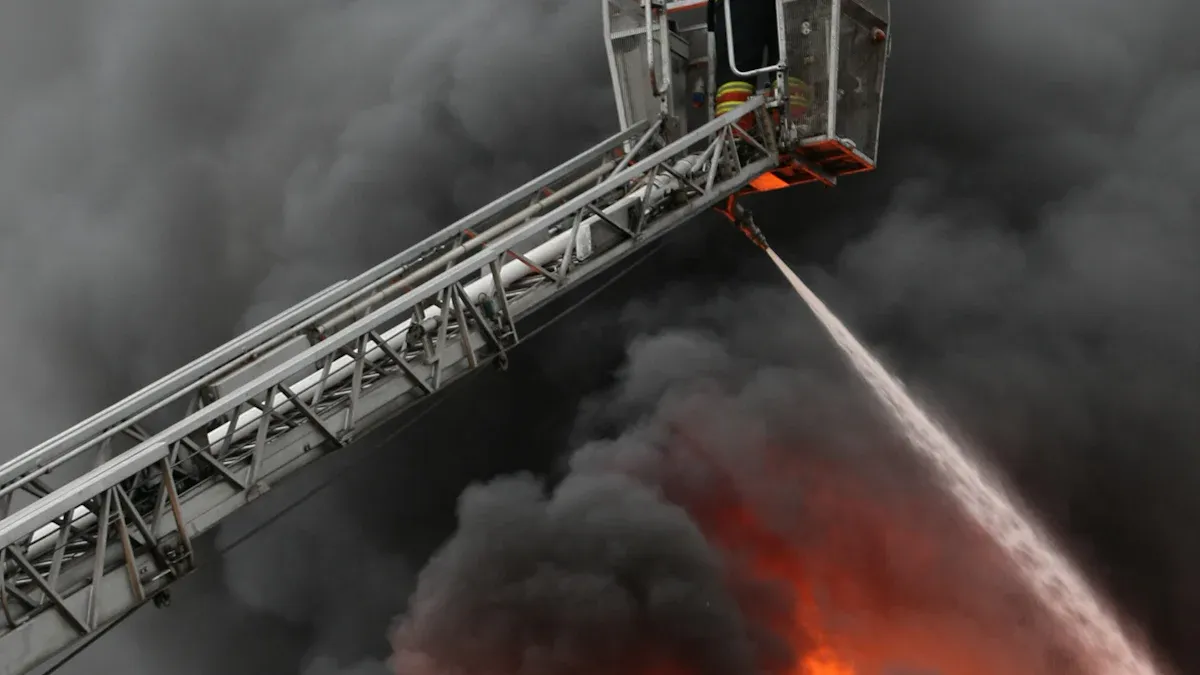
Public safety agencies now use advanced public safety drones like the Teal 2, BRINC Lemur 2, Inspired Flight IF800 Tomcat, JOUAV CW-15 VTOL, DJI Matrice 30T, Mavic 3 Thermal, Skydio X10, Parrot Anafi USA Gov, and Teledyne FLIR SIRAS. These drones for public safety help with fast response, Blue UAS approval, and have features like thermal cameras, night vision, and VTOL. Public safety drones help with important jobs in search and rescue, law enforcement, and emergency response. The market for public safety drones is getting bigger, with a predicted growth rate of 13.1% each year from 2023 to 2032. Agencies think these drones are very important for rescue work and daily public safety tasks.
Key Takeaways
Public safety drones help teams act faster and safer in search and rescue, police work, and disaster help. Top drones in 2025 have features like thermal cameras, night vision, long flying time, and easy ways to switch tools for each job. Agencies need to pick drones that match their needs, follow FAA rules, and keep data safe to protect privacy and follow the law. Training and support are needed for safe and good drone use, so teams get the most from their programs. New FAA rules and Blue UAS approvals make drones safer and let teams fly in more ways for public safety jobs.
Top Public Safety Drones
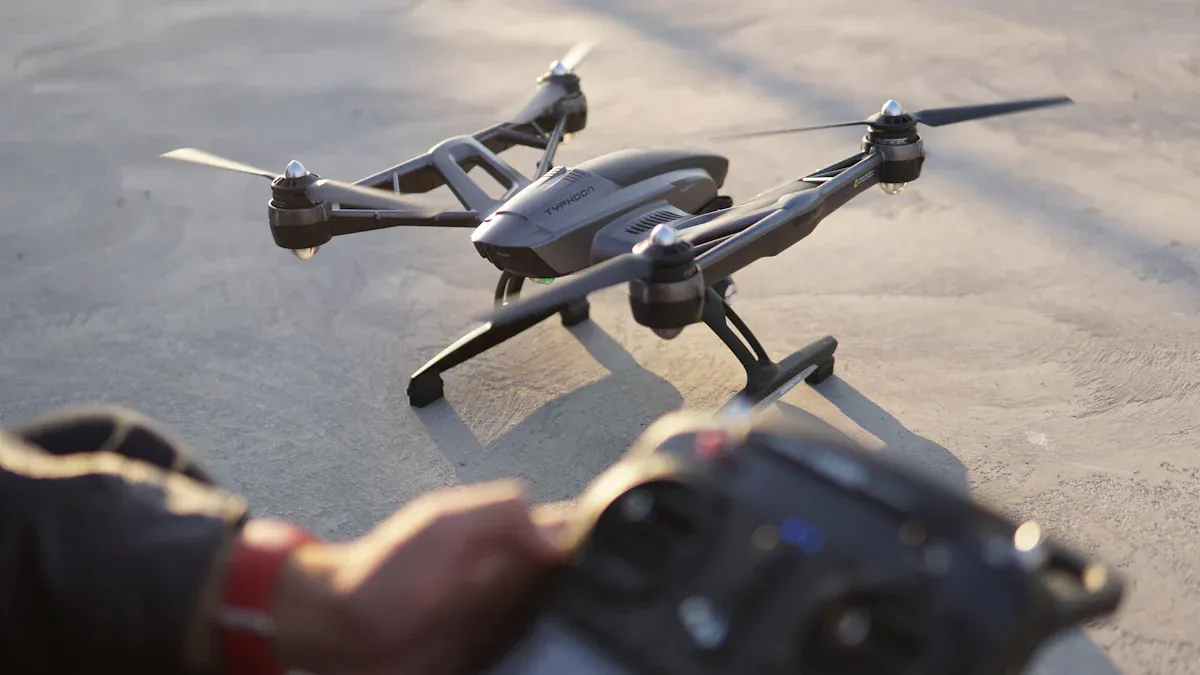
Leading Models
In 2025, public safety drones come from the U.S. and other countries. Agencies use these drones for quick action and clear pictures. They also like how drones can do many jobs. The table below shows the top public safety drone models and which agencies use them most:
Drone Model | Manufacturer | Key Features & Usage | Agencies / Adoption Highlights |
|---|---|---|---|
Indago 4 | Lockheed Martin | Foldable quadcopter, secure radios, advanced cameras, AI video processing, high payload ratio | Used by military, firefighters, UK Ministry of Defence, U.S. Forest Service |
Stalker XE | Lockheed Martin | Fixed-wing with vertical flight, border surveillance, special forces missions | UK Ministry of Defence |
LEMUR S | BRINC Drones | Two-way communication, night vision, glass-breaking, real-time awareness | NYPD, 600+ public safety agencies globally |
Responder | BRINC Drones | First responder drone, LiveOps streaming and incident coordination | Public safety and emergency response agencies |
Teal 2 | Teal Drones | Compact, night vision, AI object detection, swarm capabilities | U.S. Army Blue UAS list |
Matrice & Mavic Series | DJI | Thermal/zoom cameras, cloud data management, search & rescue, law enforcement | Widely used globally in public safety |
ANAFI USA | Parrot SA | Security and defense focus, NATO adoption, FLIR thermal sensor | NATO and allied institutions |
North America leads the drone market. The U.S. Department of Homeland Security and police use many drones. The U.S. has one of the biggest public safety drone fleets. They focus on training and following rules. New technology helps drones carry more, fly longer, and fly by themselves. Cities now use drones for jobs like watching crowds and keeping people safe.
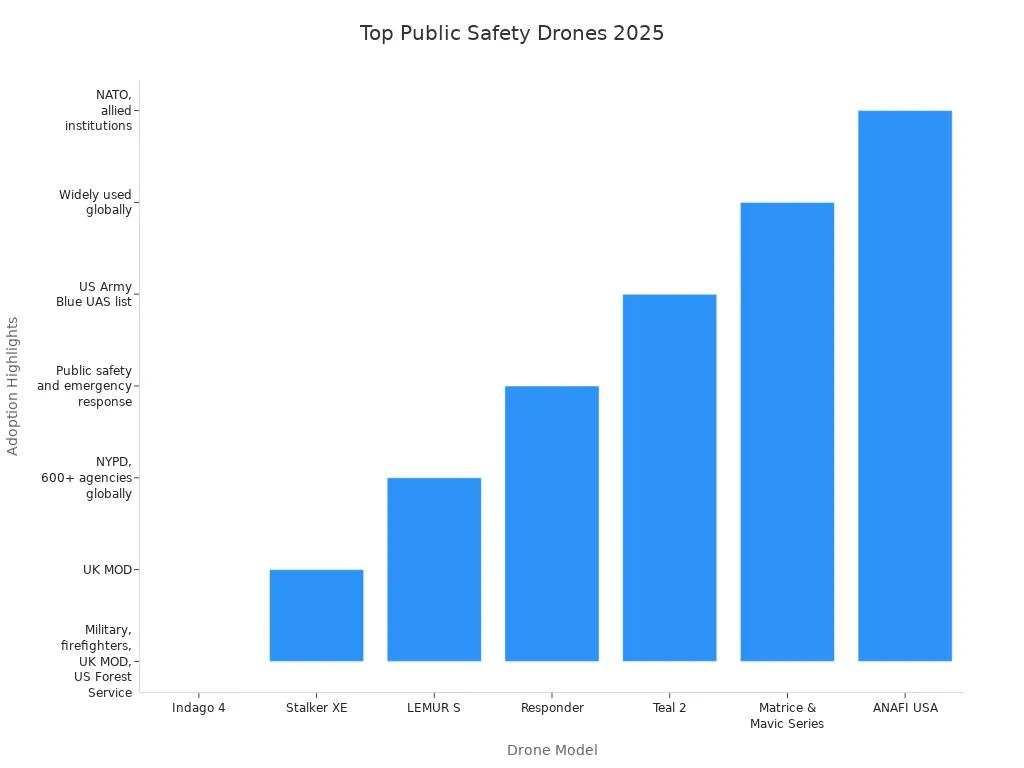
DJI is a top brand for public safety drones. Their drones have great cameras and can fly well. Many agencies around the world use DJI drones. Skydio is known for drones that can fly by themselves. They make new drones for first responders. Other important brands are Parrot, Teledyne FLIR, Lockheed Martin, and Textron. Some companies work together, like Skydio and Axon, to help more agencies use drones.
Note: Drones for public safety save money and keep people safer. They also have strong cameras. The JOUAV CW-15 VTOL can fly fast and stay in the air a long time. Teledyne FLIR SIRAS is good for checking heat safely. Parrot Anafi USA is small and has strong cameras for many types of missions.
Blue UAS Approved Drones
Blue UAS approval means public safety drones follow strict security rules. U.S. government agencies need these rules. The table below lists the most used Blue UAS drones in 2025 and why they matter for public safety:
Drone Model | Key Features & Capabilities | Relevance to Public Safety Agencies in 2025 |
|---|---|---|
DJI Mavic 3 Thermal | 640×512 thermal camera, 48MP visual camera, 36-42 min flight time, 10 km HD transmission | Popular for inspection and public safety due to thermal imaging and ease of use |
Autel EVO Max 4T | 640×512 thermal sensor, 160x hybrid zoom, laser rangefinder, 42 min flight, 12.4 mile range | Favored for long-range missions and thermal imaging in public safety |
DJI Matrice 350 RTK | Up to 55 min flight, 20 km transmission, multiple cameras, high payload capacity | Flagship platform with robust features for diverse public safety operations |
Skydio X2E | 35 min flight, 360° obstacle avoidance, 4K + FLIR thermal, NDAA compliant, 6-10 km range | Known for autonomy and ruggedness, suitable for situational awareness missions |
ACSL SOTEN | NDAA-compliant, 25 min flight, swappable payloads, IP43 rating, SO15408 security standards | Compact, secure drone ideal for demanding public safety tasks |
WingtraOne Gen II | VTOL mapping drone, 59 min flight, 61 MP camera, high mapping accuracy | Used for fast, accurate surveying and mapping in public safety and emergency response |
American-made drones like Teal 2, BRINC Lemur 2, and Inspired Flight IF800 Tomcat are known for safety and following rules. These drones can change parts, keep data safe, and fly for a long time. Agencies pick Blue UAS drones to keep information safe and follow laws. More states now limit drones made in other countries.
When we compare American-made drones to others, U.S. drones focus on safety and following rules. They cost more but are very accurate and last longer. They also have good support. Drones from other countries, like DJI, have more features and can move better. But they are not always allowed in U.S. government work because of safety worries.
Aspect | American-Made Drones | Global Competitors (e.g., DJI) |
|---|---|---|
Cost | Generally 3 to 5 times more expensive due to manufacturing costs | More affordable, offering cost-effective solutions |
Security & Compliance | NDAA compliant, AES-256 encryption, legislative support restricting foreign drones (e.g., DJI banned) | Security concerns leading to restricted use in U.S. government sectors |
Features | Modular designs, adaptable payloads, thermal and high-res visual sensors, motor failure detection | Broad feature sets, high maneuverability, creative filming capabilities |
Legislative Impact | Supported by laws like NDAA, state bans (Florida, Texas, Arkansas) fostering domestic adoption | Restricted in U.S. government and public safety sectors due to security concerns |
Adoption | Growing among U.S. public safety agencies due to mandates and data security concerns | Dominant global market share (~70%), broad adoption worldwide |
Support & Deployment | Backed by organizations like UVT offering training, fleet management, and tailored solutions | Large-scale commercial support but limited in U.S. government sectors due to restrictions |
Flight Capabilities | Longer flight times (e.g., 43-54 minutes), stable flight with safety features, but some trade-offs in maneuverability | High maneuverability, VTOL capabilities, but potential security vulnerabilities |
Public safety drones in 2025 are flexible, safe, and can fly for a long time. Agencies pick drones based on what they need for each job. They also look at rules and support. The drone market keeps changing. New features and teamwork between companies help shape the future of public safety drones.
Public Safety Drone Use Cases
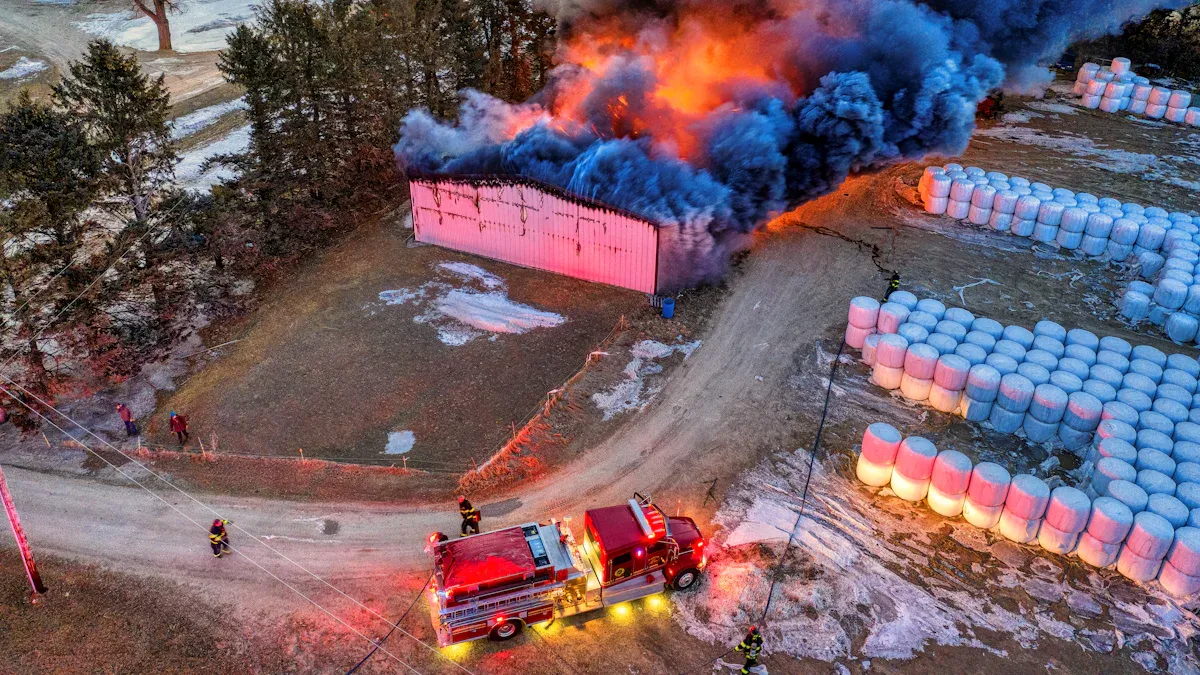
Search and Rescue (SAR)
Public safety drones have changed how search and rescue works. These drones fly over large areas quickly and send live video. This helps teams find missing people faster. Drones with thermal imaging can see people in the dark or thick woods. From 2017 to mid-2018, drones helped save more than twice as many people as before. This shows drones make rescues better. Drones can bring supplies to places that are hard to reach. They use loudspeakers to talk to people who need help. Drones shine lights at night to help rescuers see. This makes rescue work safer and faster. Now, over 180 fire departments and many public safety agencies use drones for search and rescue. This shows drones are becoming more important.
Tip: Drones help find people faster and make rescues safer. They are very helpful during big storms like hurricanes and earthquakes.
Law Enforcement Operations
Law enforcement uses public safety drones to get live information and watch from above. Drones help find dangerous people and collect evidence. They also watch big crowds at concerts or sports games. Some agencies use drones to spot threats at these events. Drones help catch suspects by following them and finding objects. Since 2010, some states let police use non-lethal drones for crowd control. These drones can use tasers or pepper spray. Drones with special sensors help police find other drones and work together in emergencies. These new tools keep officers safer and help protect the public.
Firefighting and Disaster Response
Drones are very important for fighting fires and helping after disasters. The table below shows how drones help and what they do:
Use Case | Drone Feature | Measurable Benefit |
|---|---|---|
Aerial situational awareness | 360° stabilized cameras | Real-time visibility improves crew safety |
Locating heat sources and victims | FLIR thermal sensors | Faster rescues and efficient extinguishing |
Search and rescue in low visibility | Night vision and zoom-enabled thermal cameras | Reduced search time, better victim outcomes |
Hazardous area inspection | Obstacle-avoidance sensors, live video feed | Up to 30% less firefighter exposure |
Live video to command centers | LTE/5G streaming | Over 40% better decision-making accuracy |
Post-incident assessment and training | 4K video, 3D mapping | Improved training and fire cause analysis |
Drones help leaders make quick choices and keep first responders safe. They bring rescue gear and check damage after disasters. This helps with recovery and planning for the future.
Drone as First Responder (DFR) Programs
Drone as First Responder programs are becoming more common, but less than 10% of U.S. law enforcement uses them. These programs send drones to emergencies before people arrive. Drones look at the scene and send back important information. Sometimes, drones solve problems so officers do not need to go. In some places, about 24% of calls are handled by drones alone. This saves time and money. As more agencies see the good results, more are starting DFR programs.
Features of Public Safety Drones
Thermal and Night Vision Cameras
Thermal and night vision cameras are very important for public safety drones. These sensors help first responders see what is happening right away during emergencies. Drones with thermal imaging can find body heat. This makes it easier to find missing people in forests or after disasters. Law enforcement uses these cameras to follow suspects and watch at night. This keeps officers safer. Firefighters use thermal sensors to find hot spots and watch how fires spread. Night vision lets teams see dangers without getting too close. These features help teams check big areas fast and act quickly when something happens.
Tip: Using thermal and night vision with object detection helps agencies find people and dangers even when it is hard to see.
VTOL and Tethered Systems
VTOL and tethered systems make public safety drones more useful. VTOL drones can take off and land in small spaces. This is good for cities. Tethered drones get power from a cable, so they can stay in the air a long time. They are great for watching crowds or disaster areas. These drones can be ready fast and reach 200 feet in just a few minutes. Tethered drones can also help with communication during emergencies. They carry EO/IR sensors for day and night work. Agencies like these features for crowd control, keeping areas safe, and watching for a long time.
Operational Advantage | Description |
|---|---|
Tethered power lets drones fly as long as needed. | |
Drones can be set up and sent up quickly. | |
Continuous Surveillance | Drones stay at one height to watch all the time. |
Communication Relay Payloads | Drones help networks reach farther in disasters. |
Mission Flexibility | Drones can carry different tools for many jobs. |
Flight Time and Range
Flight time and range show how long drones can fly and how far they go. Most public safety drones in 2025 can fly for 30 to 40 minutes on one battery. Some new drones can fly up to 55 minutes. How far drones go depends on rules about seeing the drone, usually 1 to 2 miles. Hot-swappable batteries let teams change batteries fast. This keeps drones flying longer. This is important for jobs like search and rescue or helping after disasters.
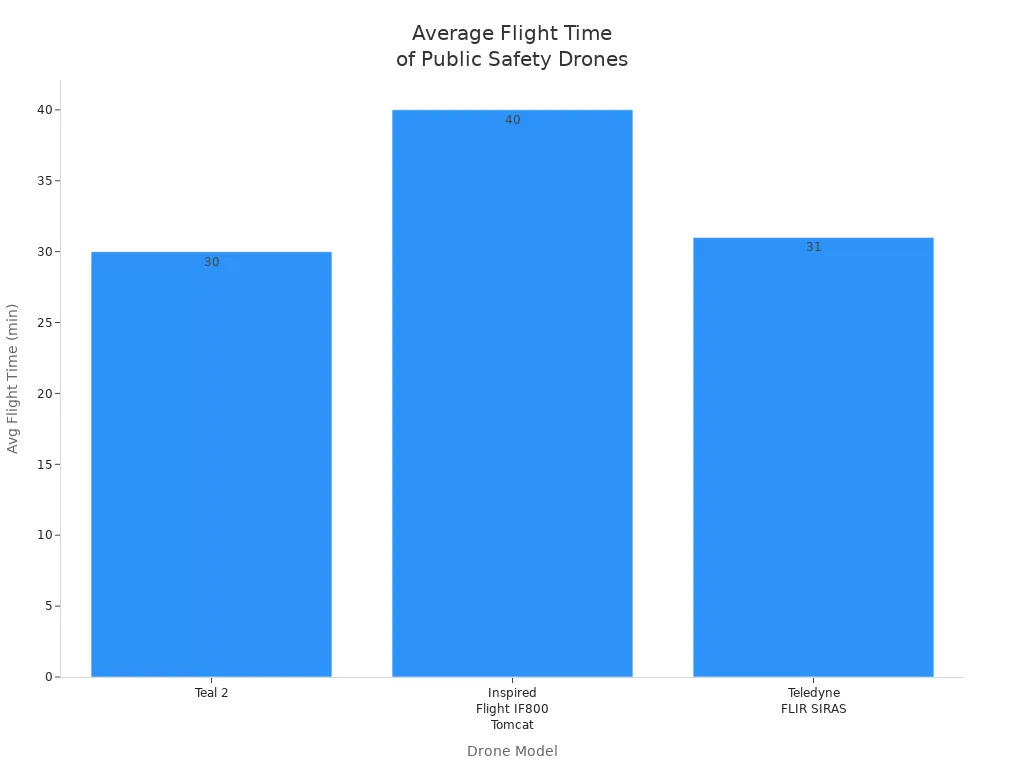
Payload and Integration
Payload choices and integration make drones better for public safety. Agencies use different payloads like thermal cameras, loudspeakers, spotlights, and non-lethal tools. These help light up crime scenes, make announcements, and help with special police work. Drones can send live video and data to crime centers and dispatchers. Modular designs let teams change drones for each job. Strong, weatherproof drones work in any weather. Payload weight and how things fit together can change how long drones fly and how steady they are, so teams must pick the right tools for each mission.
Choosing the Right Public Safety Drone
Mission Requirements
Public safety agencies need to pick drones that fit their jobs. Each job, like search and rescue or law enforcement, needs special features. Agencies want:
Drones that work with emergency systems for easy teamwork.
Drones that can carry things like gas sensors or medical kits.
Drones that send live data to command centers for fast choices.
Thermal and night vision cameras to find people in dark places.
GPS maps that help guide rescue teams.
Drones that are tough and can handle bad weather.
Drones that can fly in hard places like forests or broken buildings.
Drones that can be ready to fly very quickly.
Drones that do not cost too much to buy or fix.
Mission Use Cases | Key Features and Criteria | |
|---|---|---|
BRINC LEMUR 2 | Indoor tactical ops, hostage | Night vision, thermal, two-way audio, glass breaking |
Skydio X2 | Surveillance, mapping | AI navigation, 4K HDR, thermal camera |
DJI Matrice 350 RTK | SAR, tactical ops | 55 min flight, multiple payloads, searchlight, loudspeaker |
Parrot ANAFI USA | SAR, inspection | Dual cameras, 32x zoom, IR, weather resistance |
DJI Mavic 3 Thermal | SAR, night ops | 48 MP visual, thermal, 56x zoom, weather resistance |
People buying drones should think about how these features help their agency every day and in emergencies.
Compliance and Regulations
Public safety agencies must follow many rules when using drones. Rules can be different in each place, so it can be hard to keep up. Agencies must:
Use NDAA-compliant drones to meet security rules.
Follow FAA Part 107 rules, like not flying out of sight.
Keep data private with strong security and encryption.
Get ready for new bans on drones that do not follow rules.
Use geofencing to keep drones in safe areas.
Keep good records for checks and reports.
Waiting too long to switch to the right drones can cause problems. Agencies should act early to avoid trouble and be ready for missions.
Tip: Working with rule makers and keeping good records helps agencies follow rules and avoid delays.
Support and Training
Support and training are very important for good drone programs. Most agencies use pilots who have other jobs, so training is needed. Programs like DRONERESPONDERS UNITE give:
Online classes and leader lessons for basic learning.
Local workshops for hands-on practice.
Special training made for each agency.
Events like UTAC 2025 give real-life training with real situations. These programs help agencies make strong leaders and good drone teams. People buying drones should look for sellers who give support, updates, and certified training.
Agencies that spend money on training and support get better results, safer flights, and more value from their drones.
Regulatory and Compliance Considerations
FAA Part 107 and BVLOS
Public safety agencies must follow FAA Part 107 rules. These rules say drones must stay in sight and away from airports. In 2025, the FAA made new changes to help agencies. Some agencies can now fly drones as first responders without a visual observer in Class G airspace. There is also a new waiver for shielded operations. This lets agencies fly drones up to one mile beyond visual line of sight (BVLOS) for public safety. The FAA made the Certificate of Waiver (COW) system. This system puts different approvals together and makes things faster. These changes help agencies act quickly and safely in emergencies.
Note: The FAA is still working on bigger BVLOS rules. As of mid-2025, these rules are not finished for all drone operators.
Data Security and Privacy
Data security and privacy are very important for public safety drone programs. Agencies must keep sensitive information safe from hackers and people who should not see it. They use strong encryption like AES-256 and secure ways to send data. Many drones now have Local Data Mode. This stops data from leaving the drone. Agencies use private-cloud or on-premises storage to control where data goes. Privacy worries include taking pictures or videos without permission. Agencies follow clear rules, use encrypted transmissions, and tell the public what they do. Lawmakers and civil rights groups want strict rules. These rules include needing warrants and limiting how long data is kept. Using drones the right way and talking openly helps build trust with the community.
Agency Policies
Agency policies tell how drones are used for public safety. Every drone over 0.55 pounds must be registered with the FAA. Agencies must certify pilots under Part 107 or get a Certificate of Authorization (COA) to fly as public aircraft. Policies set rules for when and how drones can be used. This includes emergencies, investigations, or tactical missions. They often limit flights at night, over people, or near airports unless there is a waiver. Agencies need training, documentation, and public notice before flights. They also have steps for handling complaints or unsafe drone use. Agencies must update their policies often to match new laws and technology. By following these rules, agencies help keep communities safe and respect legal and privacy standards.
Public safety drones in 2025 give agencies new ways to help people. They are used for search and rescue, law enforcement, and disaster response. The best drones can be sent out quickly. They have powerful cameras and keep data safe. Agencies can find problems early and track things with AI. Drones can also change to fit different rescue needs.
Training and following FAA rules are very important for safe use.
Agencies should talk to vendors, try out drones, and change their drone rules to follow new laws and keep the community’s trust.
FAQ
What is Blue UAS approval, and why does it matter?
Blue UAS approval shows a drone meets tough U.S. security rules. Agencies pick Blue UAS drones to keep important data safe. This helps them follow federal laws. It also helps avoid legal trouble. Blue UAS approval makes sure drones work safely and well.
How long can public safety drones fly on a single battery?
Most public safety drones in 2025 fly for 30 to 55 minutes. Teams can swap batteries fast with hot-swappable batteries. This lets drones stay in the air longer during important missions.
Can agencies use drones at night or in bad weather?
Many public safety drones have thermal and night vision cameras. These help teams work at night or when it is hard to see. Drones with weather-resistant designs can fly in rain, wind, or snow. Agencies should always check the maker’s rules before flying.
What training do drone pilots need for public safety missions?
Pilots must have an FAA Part 107 certificate. Many also get special training for search and rescue or law enforcement. Pilots keep learning and practicing to be ready for real missions.
Are there privacy concerns with using drones for public safety?
Yes. Agencies must keep personal data safe and follow privacy laws. They use encrypted links and clear rules for storing data. Agencies also tell the public about drone use to build trust and answer privacy worries.
See Also
Using Thermal Imaging Cameras Effectively For Rescue Missions 2025
The Importance Of Thermal Imaging Cameras In 2025
Best AI Video Devices For Vehicles Reviewed In 2025
Vanadium Oxide Thermal Cameras Designed For Rescue Operations
